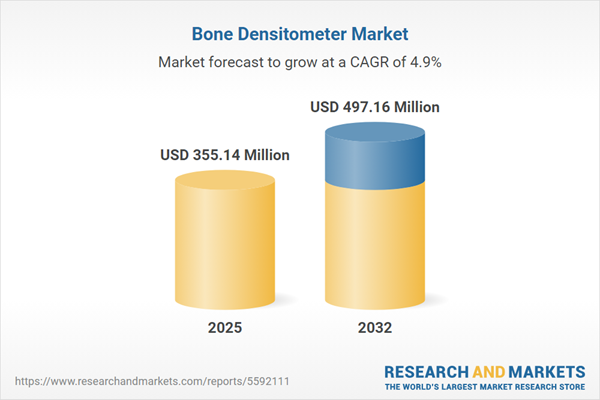Speak directly to the analyst to clarify any post sales queries you may have.
Bone densitometry solutions are becoming increasingly foundational to clinical care strategies focused on osteoporosis diagnosis and personalized fracture risk management. Senior decision-makers are turning to this market to improve diagnostic accuracy, streamline workflows, and optimize patient outcomes in both established and emerging healthcare settings.
Bone Densitometer Market Snapshot
The bone densitometer market grew from USD 338.07 million in 2024 to USD 355.14 million in 2025, maintaining momentum with a CAGR of 4.93% and forecast to reach USD 497.16 million by 2032.
This trajectory reflects the critical demand for advanced musculoskeletal assessment, as well as evolving clinical guidelines that encourage the integration of quantifiable imaging with routine practice. Ongoing investments in technology, coupled with reimbursements aligned to value-based care, further support high adoption rates globally.Scope & Segmentation
- Modality Types: Central DXA, Quantitative Ultrasound, Peripheral DXA
- Clinical Settings: Diagnostic centers, hospitals, specialized clinics, and rehabilitation facilities
- Key Applications: Fracture risk assessment, osteoporosis assessment, monitoring of therapeutic outcomes, routine screenings, and musculoskeletal health programs
- Regional Coverage: Americas (including North America, Latin America), Europe, Middle East, Africa, and Asia-Pacific, incorporating major markets such as United States, Canada, Brazil, Germany, China, India, Japan, and Australia
- Company Coverage: Hologic, Inc.; GE HealthCare Technologies Inc.; Siemens Healthineers AG; DMS Group, Inc.; Hitachi Aloka Medical, Ltd.; OsteoSys Co., Ltd.; Norland Medical Systems, Inc.; Mindways Software, Inc.; Medilink Co., Ltd.; Sunlight Medical Ltd.
Key Takeaways for Senior Decision-Makers
- Bone densitometer adoption is underpinned by technological innovation targeting higher imaging resolution and improved data integration within electronic medical records.
- Shift toward portable and point-of-care systems is expanding access beyond traditional hospital infrastructure, bringing early detection capabilities closer to patient populations.
- Artificial intelligence and predictive modeling are reshaping fracture risk identification, supporting targeted interventions and more proactive care plans.
- Emerging care models emphasize outcome-driven reimbursement, prioritizing early detection and personalized monitoring to control costs and enhance value.
- Providers are increasing investments in staff training and remote maintenance solutions, maximizing device uptime while reducing operational constraints.
Tariff Impact
The introduction of United States trade tariffs in 2025 increased procurement complexities for bone densitometer equipment. Manufacturers responded by adjusting supply chains, sourcing domestic alternatives, and exploring leasing models for hospitals and diagnostic centers. These adaptive strategies enabled healthcare providers to mitigate cost pressures while maintaining uninterrupted access to diagnostic technologies.
Methodology & Data Sources
This research utilizes a multi-methodological approach, combining direct interviews with key industry stakeholders including clinicians, engineers, and procurement experts. Secondary data from regulatory filings, academic journals, and industry reports were cross-referenced to validate findings and minimize bias. Rigorous triangulation and data integrity checks establish high credibility for the reported market insights.
Why This Report Matters
- Enables executives to benchmark strategic procurement, investment, and technology adoption decisions in bone densitometry against validated industry trends.
- Offers transparency in methodology, giving confidence in scenario planning for response to trade policy or supply chain fluctuations.
- Identifies growth opportunities in underpenetrated segments, regions, and emerging technologies to support long-term competitive advantage.
Conclusion
The bone densitometer market is shaped by continuous innovation and global health imperatives. Forward-thinking organizations leveraging data-driven strategies and collaborative partnerships will remain central to next-generation musculoskeletal care.
Additional Product Information:
- Purchase of this report includes 1 year online access with quarterly updates.
- This report can be updated on request. Please contact our Customer Experience team using the Ask a Question widget on our website.
Table of Contents
3. Executive Summary
4. Market Overview
7. Cumulative Impact of Artificial Intelligence 2025
Companies Mentioned
The companies profiled in this Bone Densitometer market report include:- Hologic, Inc.
- GE HealthCare Technologies Inc.
- Siemens Healthineers AG
- DMS Group, Inc.
- Hitachi Aloka Medical, Ltd.
- OsteoSys Co., Ltd.
- Norland Medical Systems, Inc.
- Mindways Software, Inc.
- Medilink Co., Ltd.
- Sunlight Medical Ltd.
Table Information
| Report Attribute | Details |
|---|---|
| No. of Pages | 192 |
| Published | October 2025 |
| Forecast Period | 2025 - 2032 |
| Estimated Market Value ( USD | $ 355.14 Million |
| Forecasted Market Value ( USD | $ 497.16 Million |
| Compound Annual Growth Rate | 4.9% |
| Regions Covered | Global |
| No. of Companies Mentioned | 11 |









